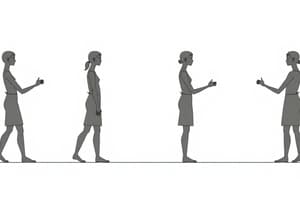Podcast
Questions and Answers
Which property of congruent figures ensures that every part of one figure corresponds exactly with every part of another figure?
Which property of congruent figures ensures that every part of one figure corresponds exactly with every part of another figure?
- Corresponding Parts (correct)
- Scaling
- Rigid Motions
- Superposition
If two triangles are congruent, what can we say about their sides?
If two triangles are congruent, what can we say about their sides?
- They have different lengths
- They are not related
- Their lengths can vary
- They have equal length (correct)
What type of motion is responsible for maintaining the congruence of figures?
What type of motion is responsible for maintaining the congruence of figures?
- Rotation (correct)
- Scaling
- Expansion
- Shearing
If a figure undergoes shearing, what happens to its congruence with the original figure?
If a figure undergoes shearing, what happens to its congruence with the original figure?
How do congruent figures behave when they are superimposed?
How do congruent figures behave when they are superimposed?
What property states that any given triangle is congruent to itself?
What property states that any given triangle is congruent to itself?
If Figure A is congruent to Figure B, and Figure B is congruent to Figure C, according to which property is Figure A also congruent to Figure C?
If Figure A is congruent to Figure B, and Figure B is congruent to Figure C, according to which property is Figure A also congruent to Figure C?
In a pair of congruent figures, which property ensures that angles between lines correspond to the same angle measure?
In a pair of congruent figures, which property ensures that angles between lines correspond to the same angle measure?
If Figure A is congruent to itself, what property of congruence is being exemplified?
If Figure A is congruent to itself, what property of congruence is being exemplified?
Which property of congruence states that if Figure A is congruent to Figure B, and Figure B is congruent to Figure C, then Figure A must also be congruent to Figure C?
Which property of congruence states that if Figure A is congruent to Figure B, and Figure B is congruent to Figure C, then Figure A must also be congruent to Figure C?
Flashcards are hidden until you start studying
Study Notes
Congruent figures are shapes that have exactly the same dimensions and resemble each other so closely that they can be superimposed without leaving any gaps. In other words, when two figures are congruent, you could cut one out of paper and place it directly over the other without any pieces hanging off. This is because every part of one figure corresponds exactly with every part of the other, including lengths of lines and angles between them.
Properties of Congruent Figures
Congruent figures have several key properties that make them distinct from other types of similar figures. These properties include:
-
Corresponding Parts: Every part of one figure has a corresponding part in another figure that covers the exact same space and is equal in size and shape. For example, if we consider two triangles, their pairs of sides will always be equal in length, and their interior angles will always be equal in measurement.
-
Superposition: As mentioned earlier, congruent figures can be superimposed on top of each other, meaning they can be overlapped and placed directly onto each other without creating gaps.
-
Rigid Motions: Congruence can only occur due to rigid motions like translation or rotation, which involve moving the entire figure without changing its shape or size. When a figure undergoes a non-rigid motion such as scaling or shearing, it does not remain congruent with itself after the transformation.
-
Angles and Sides: Angles between lines in a pair of congruent figures correspond to the same angle measure, and segments joining points within a pair of congruent figures correspond to segments having the same length.
-
Reflexive Property: A figure, say (A), is considered congruent to itself, i.e., (A \sim A). This property states that any given triangle is congruent to itself, since all three sides have the same length, and all internal angles are equal to 60 degrees, 90 degrees, or 180 degrees.
-
Symmetric Property: If (A \sim B) and (B \sim C), then (A \sim C). This means that if Figure A is congruent to Figure B, and Figure B is congruent to Figure C, then Figure A must also be congruent to Figure C.
-
Transitive Property: If (A \sim B) and (B \sim C), then (A \sim C). This implies that if Figure A is congruent to Figure B, and Figure B is congruent to Figure C, then Figure A must also be congruent to Figure C.
These properties are essential in understanding the concept of congruence and applying it across various mathematical contexts. They form the basis of many proofs and solutions to geometry problems involving congruent figures.
Studying That Suits You
Use AI to generate personalized quizzes and flashcards to suit your learning preferences.




